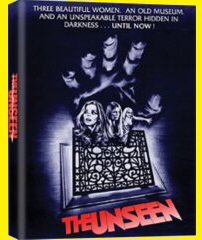
Enlivening a standard slasher formula with old world atmosphere, believably eccentric characters, and a dated setting that curiously adds a sense of tension to the stalk and slash hysterics, The Unseen is an unsung classic of the Body Count era. Directed by Peter Foleg and written by Michael L. Grace, this unfairly neglected thriller is enveloped in a palpable air of menace. Suspense is allowed to develop slowly and naturally, and the characters are fleshed out with surprising intimacy. This, combined with the isolation suggested by the setting of an isolated farmhouse makes this film an elegantly told classic of American Gothic. While it received a limited theatrical run and poor publicity, cable television earned it a cult following. Code Red salvages this eccentric chiller and supports it with an exhaustive array of extras.
Sexy TV reporter Jennifer Fast (Barbara Bach) and her two attractive assistants visit the town of Soveg, California to cover the Danish festival. They find themselves without lodging for the night and are thankful when friendly local Ernest Keller (Sydney Lassick) invites them to spend the night at his farmhouse, a Victorian style residence that bleeds atmosphere. Ernest lives with his wife Virginia, a timid, secretive shadow of a woman, and ghosts of a tragic past. The women don't realize that something horrible is hiding in the basement. Something that is horribly-deformed and mentally ill. This offspring of inbreeding isn't going to stay in the cellar much longer . . .
The distinct pleasures of The Unseen have little to do with the originality of the story. In fact, the plot and themes are largely burrowed from already stale slasher film conventions. The premise of a group of shapely young females is a standard convention culled from any number of urban legends and campfire tales, and served as a starting off point for several horror films of the period. The secretive family and 'hidden' monster are also hoary clichés. The style and tone save these story elements from ruin. Emotional suspense is emphasized instead graphic violence. In a cinematic era when Body Count madness ran rampant through the genre, it was refreshing to see filmmakers craft a story dependent largely on mood and atmosphere rather than a slapdash barrage of gore. This isn't to say that there is a shortage of chilling characterization or chills to be had. And the effects, while not poured on by the gallon, are quite effective when sparingly used. The situation of the all too human monster is particularly effective, especially with make-up conceived and applied by Craig Reardon. In short, this is a modern monster movie that emphasizes the cruelty and degeneracy of human beings, crosses taboos of theme, and leaves an unsavoury feeling in the back of your throat. Just as any decent horror movie should.
Code Red treats The Unseen with dedication and technical polish. The movie is presented in 1.85:1 widescreen with anamorphic enhancement. Image clarity is usually quite good, despite some grain and the occasional soft picture, which in all fairness seem to stem from the original print. A detailed amount of detail is consistent and the colors are lively and sharp. Audio is in Mono English, clean and without any noticeable background interference.
Extras are superb, lovingly detailing the genesis of the film, its complications, and the special effects convincingly interwoven in the story. Disc One features the most informative piece of the set, an Audio Commentary with Furst and Tony Unger, moderated by Lee Christian. The commentary is precise and enjoyable, exploring several aspects of the title as well as other projects in their careers. While the conversation often weaves off topic, the atmosphere is humorous and we walk away with a solid sense of understanding. Next up are Interviews with Furst and Burr. A Theatrical Trailer is accompanied by spots for other Code Red releases, followed by an impressive Stills Gallery. Disc Two features two lengthy Interviews with FX artists Craig Reardon and Tom Burman. The former recounts, in surprising detail, various elements of his work on the film. The later reviews his initial invitation to join the picture and why he felt compelled to alter the story, which led to his leaving the production. Of interest to the effects enthusiast are the inclusion of Make Up Tests slides, sketches and behind-the-scenes photos from Reardon's personal collection. This DVD is a first rate presentation of an elegantly told tale of sleaze.
Review by William Simmons
| Released by Code Red |
| Region 1 - NTSC |
| Not Rated |
| Extras : |
| see main review |